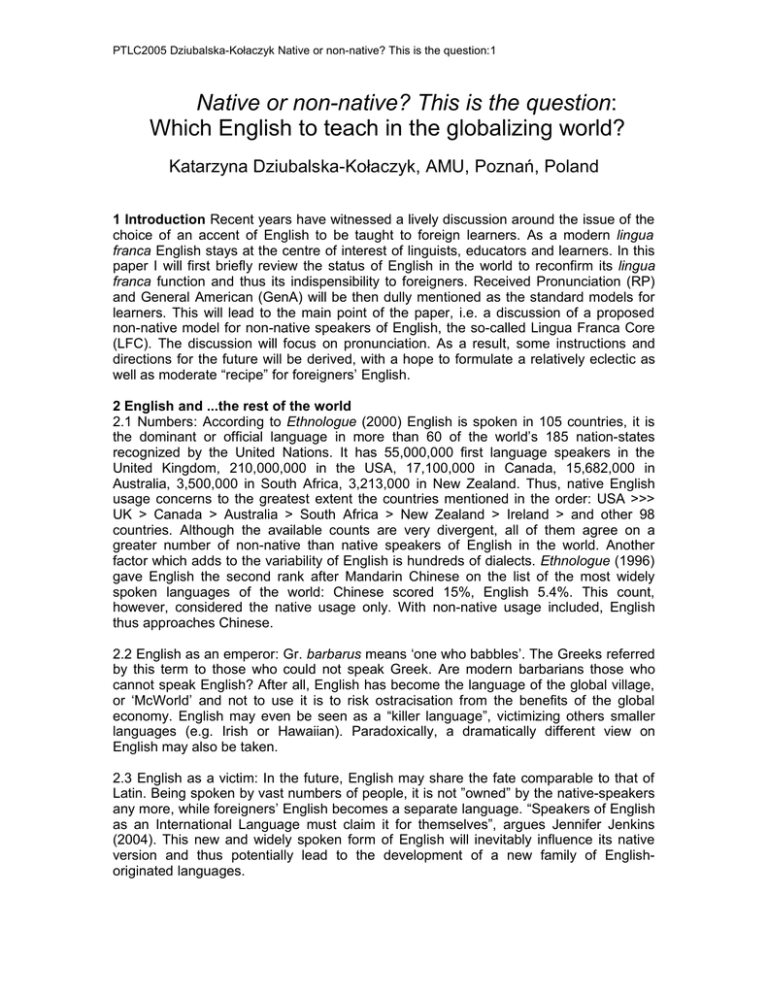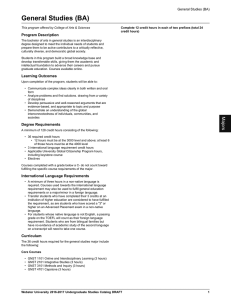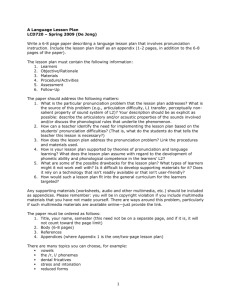Native or non-native? This is the question
advertisement

PTLC2005 Dziubalska-Kołaczyk Native or non-native? This is the question:1 Native or non-native? This is the question: Which English to teach in the globalizing world? Katarzyna Dziubalska-Kołaczyk, AMU, Poznań, Poland 1 Introduction Recent years have witnessed a lively discussion around the issue of the choice of an accent of English to be taught to foreign learners. As a modern lingua franca English stays at the centre of interest of linguists, educators and learners. In this paper I will first briefly review the status of English in the world to reconfirm its lingua franca function and thus its indispensibility to foreigners. Received Pronunciation (RP) and General American (GenA) will be then dully mentioned as the standard models for learners. This will lead to the main point of the paper, i.e. a discussion of a proposed non-native model for non-native speakers of English, the so-called Lingua Franca Core (LFC). The discussion will focus on pronunciation. As a result, some instructions and directions for the future will be derived, with a hope to formulate a relatively eclectic as well as moderate “recipe” for foreigners’ English. 2 English and ...the rest of the world 2.1 Numbers: According to Ethnologue (2000) English is spoken in 105 countries, it is the dominant or official language in more than 60 of the world’s 185 nation-states recognized by the United Nations. It has 55,000,000 first language speakers in the United Kingdom, 210,000,000 in the USA, 17,100,000 in Canada, 15,682,000 in Australia, 3,500,000 in South Africa, 3,213,000 in New Zealand. Thus, native English usage concerns to the greatest extent the countries mentioned in the order: USA >>> UK > Canada > Australia > South Africa > New Zealand > Ireland > and other 98 countries. Although the available counts are very divergent, all of them agree on a greater number of non-native than native speakers of English in the world. Another factor which adds to the variability of English is hundreds of dialects. Ethnologue (1996) gave English the second rank after Mandarin Chinese on the list of the most widely spoken languages of the world: Chinese scored 15%, English 5.4%. This count, however, considered the native usage only. With non-native usage included, English thus approaches Chinese. 2.2 English as an emperor: Gr. barbarus means ‘one who babbles’. The Greeks referred by this term to those who could not speak Greek. Are modern barbarians those who cannot speak English? After all, English has become the language of the global village, or ‘McWorld’ and not to use it is to risk ostracisation from the benefits of the global economy. English may even be seen as a “killer language”, victimizing others smaller languages (e.g. Irish or Hawaiian). Paradoxically, a dramatically different view on English may also be taken. 2.3 English as a victim: In the future, English may share the fate comparable to that of Latin. Being spoken by vast numbers of people, it is not ”owned” by the native-speakers any more, while foreigners’ English becomes a separate language. “Speakers of English as an International Language must claim it for themselves”, argues Jennifer Jenkins (2004). This new and widely spoken form of English will inevitably influence its native version and thus potentially lead to the development of a new family of Englishoriginated languages. PTLC2005 Dziubalska-Kołaczyk Native or non-native? This is the question:2 3 Native models For many years it has been Received Pronunciation (RP) and General American (GenA) that have served as role models in teaching English to foreign learners. Their obvious advantages are the following: they are codified (especially RP), pedagogically verified, learnable, easy to describe for learners, a-territorial, understood by all native speakers, as well as identified with the English of the media (BBC, CNN, etc.). They constitute the basis for didactic materials while being constantly updated, for instance thanks to the available pronunciation dictionaries, published by Longman, CUP and OUP. From the phonological point of view, the standards constitute a common denominator of all accents. The opposite directions of code-switching: accent à standard and standard à accent are not mirror images; while the former guarantees intelligibility, the latter almost certainly decreases it. Consequently, one may claim that the phonology of a standard constitutes a core of accent phonologies. A standard thus appears to be a logical choice for a non-native learner as a well-described, generally accessible and intelligible variant of a language. 4 A non-native alternative: a new curriculum? One of the new proposals is to simplify the language taught to foreigners, i.e. to specify a necessary core which could become a teaching priority in an English language classroom. Jenkins (2000) argues, among others, that the main bulk of communication by the learners of English takes place among non-native speakers of the language. This reduces any need to acquire a native accent by the learner. She proposes a core (Lingua Franca Core – LFC) of ELF (English as a Lingua Franca) to replace the standard models ‘served’ to the learners so far (RP and GenA). LFC finds predecessors in the proposals like that of Gimson (1978) RIP (Rudimentary International Pronunciation) or Crystal (1997) WSSE (World Standard Spoken English). The underlying assumption of LFC is that existent syllabuses contain features which are “unnecessary, unrealistic, and (...) harmful” for the purposes of international communication. The adoption of a ”phonological core” in teaching would guarantee mutual intelligibility (especially among non-native speakers), maintenance of local identity by the learners, and learnability of important elements of the language. 4.1 Basic features of LFC: rhotic accent, pronounced as GenA retroflex approximant; no flap; no <th>; no dark l; importance of aspiration; importance of glottal h; importance of fortis/lenis contrast; cluster reduction allowed only medially and finally; importance of vowel length; vowel quality ignored; no weak forms (but learners must know them in order to understand); importance of lexical stress; rhythm, intonation, phonostylistics not important. 5 LFC: a critique Types of arguments brought up in the discussion around Lingua Franca Core range from phonetic-phonological (language-specific and universal), via philosophical, logical, and ideological, through sociolinguistic, psychological and pedagogical (cf. e.g. two workshops at Poznań Linguistic Meetings (PLM) 2003 and 2004 and the resulting publication English Pronunciation Models: A Changing Scene, edited by Dziubalska-Kołaczyk and Przedlacka. in press. Peter Lang). Below I will formulate both general and detailed critical comments that can be issued against LFC. 5.1 General comments: There is an implicit conflict between production and perception abilities of the learners. They are supposed to perceive and understand certain elements of the phonological structure without being able to produce them. This conflict is an obvious problem even for only very moderate followers of Motor Theory of Speech Perception. From the perspective of a teacher who is a model (and does not speak PTLC2005 Dziubalska-Kołaczyk Native or non-native? This is the question:3 LFC), but is not supposed to be imitated, there is an additional problem of the evaluation of students in the classroom. While native-speakers are not supposed to be models, and standards are not supposed to be the reference points, still, the learners are expected to approach RP or GenA (which is a reference to standards after all) and intelligibility and irritability are measured against native speakers, too. In this light, Jenkins’ Beware the natives and their norms! is not convincing. In the same, already quoted interview, Jennifer Jenkins says: “The result is that learners in Hong Kong, Poznan, Tokyo, etc - who are most likely to use their English with other non-native speakers - are being taught varieties of English that are more appropriate to conversation among native speakers in Brighton or Baltimore.” Apart from the pride the mention in this context brings to Poznań: it is not true that non-natives communicate only with other non-natives; so, in Brighton and Baltimore standards are spoken after all?! Typological differences among languages have been underestimated: what is simple for Poles is not simple for the Japanese (cf. the notorious liquids, consonant clusters, etc). Consequently, a typological perspective excludes a possibility of finding one common core for learners from various linguistic backgrounds. The proposed system is artificial, since an arbitrary selection is made from among the structural features of a natural language. Such a system is thus not learnable as natural languages are (it may be learnable, but we cannot assume the same acquisition process as in the case of a natural language). Finally, one would need much more empirical evidence to validate various aspects of the proposal, including the data on the expectations of the learners in a variety of learning environments as well as inter-non-native communication. 5.2 Detailed comments: Let me now comment briefly on the in-or-out status of each of – – – – – – – – – – the phonetic features mentioned in LFC, from the point of view of the universal function they play in the phonological system. rhotic accent, pronounced as GenA retroflex approximant: this sound is a result of a fortition since its articulation is complex; strengthenings always require more effort from the speaker, they are listener-friendly, so not simple to produce for the learner – in although learner-unfriendly flap: a flap or tap is relevant only from the perspective of some accents of English; it is a result of a lenition, and as such is speaker-friendly, so would be out although learner-friendly <th>: a lenition from any other neighbouring articulation, thus avoided in the languages of the world for perceptual reasons; however, out although learnerfriendly dark l: here, vocalization is suggested, which is a lenition, however, detrimental for the learner’s perception aspiration: a fortition, only allophonic in English, in although learner-unfriendly glottal h: lenitive, but there is no danger of overlap with other sounds of English fortis/lenis contrast: the cue for this contrast is mainly with the vowel rather than consonant; fortitive, in although learner-unfriendly cluster reduction: lenitive, out in the initial position although learner-friendly vowel length: fortitive, in although learner-unfriendly vowel quality: tense vowels are fortitive, lax vowels are lenitive; out although essential for the listener PTLC2005 Dziubalska-Kołaczyk Native or non-native? This is the question:4 – – weak forms: a result of prosodic lenition; out although learner-friendly lexical stress: a lexical feature; lexical stress in English is marked from the typological perspective, and thus in although learner-unfriendly – rhythm: universally essential phonologically, in English rhythm is trochaic and thus unmarked, and thus out although learner-friendly – intonation: universally essential phonologically and for its other functions (grammatical, pragmatic, etc.) – phonostylistics: universally lenitive; out although learner-friendly. Summing up, out of all the above in-or-out solutions proposed in LFC, basically none qualifies to be accepted into the “new” system from the universal functional perspective. 6 What not to do Let us not intervene into the development of a language (cf. Esperanto). The task of a linguist is to describe and explain rather than create or modify linguistic reality. If English is to share the fate of Latin or Greek, we can do nothing about it, but let us not facilitate the process by introducing and spreading non-native artificial models. Let us not deny the role of a native-speaker as an authority on his/her native language. Finally, if hundreds of millions of people learned English without LFC, “Where is the problem?” 7 What to do: a “recipe”? – Teach the generally understood and existent English based on codified standards. In fact, codified standards ARE the core of English. The standards are not monolithic and they reflect modern tendencies (cf. the updated pronunciation dictionaries). A good model is, e.g., broadcast speech (e.g., BBC English): the speech of professionals which does not evoke negative emotions (cf. Roach). – Make learners aware of variety of accents, especially by exposure. – Teach learners stylistic variability, both in production and perception. – Make use of L1: here we can find real facilitators, rather than in LFC. – Rely on learners’ cognitive abilities. “Teach native English” is the answer to the question of this paper. 8 References Dziubalska-Kołaczyk, Katarzyna & Przedlacka, Joanna (eds.) (in press) English Pronunciation Models: A Changing Scene. Linguistic Insights. Bern, Frankfurt a. Main: Peter Lang. Grimes, Barbara F. (ed.) (2000) Ethnologue. Languages of the World. SIL International. Jenkins, Jennifer (2000) The Phonology of English as an International Language. Oxford:Oxford University Press. Jenkins, Jennifer. 22.01.2004., Guardian Weekly. <http://www.guardianweekly.co.uk> Wells, J.C. 1990; 2000 Longman Pronunciation Dictionary. Longman. Jones, D. 2003 English Pronouncing Dictionary. 16th edition, edited by P. Roach, J. Hartman and J. Setter. CUP. Upton, C., Kretzschmar, W. A. Jr, & Konopka, R. 2001; 2003 Oxford Dictionary of Pronunciation for Current English. OUP.






